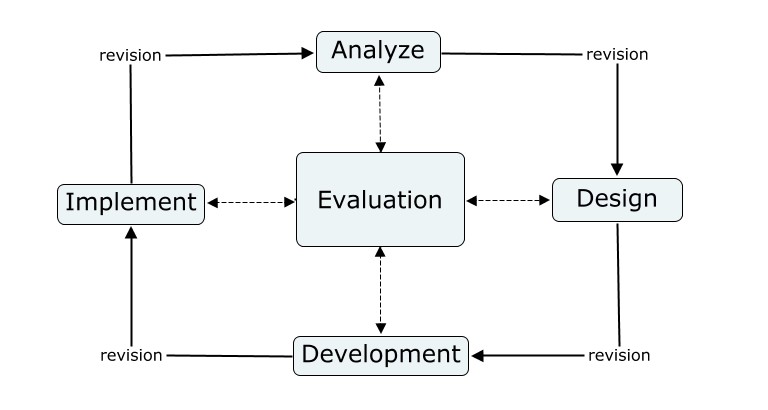Principles of course design
Designing the learning journey in your course lies at the heart of all teaching. Although the design for learning is usually hidden from students, it involves deliberate choices about what, when, where and how to teach. Decisions need to be made about the content, structure, timing, pedagogical strategies, sequence of learning activities, and type and frequency of assessment in the course, as well as the nature of technology used to support learning. Making these decisions is the process of creating your design. Federation University employ learning designers specifically to assist teaching staff with this process.
AADIE Model Source: https://commons.wikimedia.org/wiki/File:ADDIE_Model_of_Design.jpg
Source: https://commons.wikimedia.org/wiki/File:ADDIE_Model_of_Design.jpg
The ADDIE Model offers a systematic process for designing instruction to guide the scope and sequence of developing a comprehensive learning journey. It involves the analysis of learning needs and goals, and the development of a delivery system to meet those needs. It encompasses five phases:
- Analysis – An analysis of components such as audience, content, outcomes, environment and delivery media. The purpose of this phase is to gain a thorough understanding to scope the content, delivery methodology and identify any constraints.
- Design – A ‘blueprint’ to identify and develop strategies for achieving performance outcomes. Includes a detailed list of objectives, instructional and evaluation strategies, and specifications of the delivery medium. View a video demonstration on how to create a blueprint using storyboarding.
- Development – The ‘blueprint’ is translated into the product. This involves the creation of online modules, teacher manuals or resources for face-to-face classes, and student instructions or resources to engage with learning in both these delivery modes.
- Implementation – Delivery of the course, which may include a ‘test-run’ for user accessibility to identify any adjustments that may be required.
- Evaluation – The ADDIE model is not linear, thus evaluation is conducted after each phase in order to gather feedback regularly throughout the process to support and incorporate into the next phase.
Resources and assistance
Websites
- InstructionalDesign.org – ADDIE Model
- LearnUpon – ADDIE: 5 steps to build effective training programs
Assistance
- Contact your Institute Learning Designer for support in designing your course